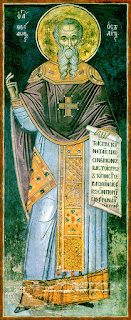Icon and Idol in the Iconology of Theodore the Stoudite

With the kind permission of Dr Ken Parry, here is an excerpt from his article, ‘ Theodore the Stoudite: The Most “Original” Iconophile?’ published in Jahrbuch der Österreichischen Byzantinistik (2018), 261-75. In countering the accusation of idolatry, as well as justifying their re-reading of the Exodus prohibition against images, the iconophiles drew a distinction between an icon and an idol. They utilized a distinction inherent in philosophical discussions of nominal definitions. In his Posterior Analytics Aristotle proposed the compound “goat-stag” (τραγέλαφος) as the name of a non-existent thing. However, Plato had earlier used the example of a goat-stag as painted by an artist who combines two animals in one. These mythological creatures, such as gorgons, sirens and griffins, were to be seen in Greek art. This idea of an imaginary animal was discussed by Origen who gave the example of a centaur because it exists only in the imagination. In doing so, he drew a dis...